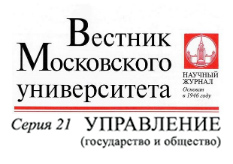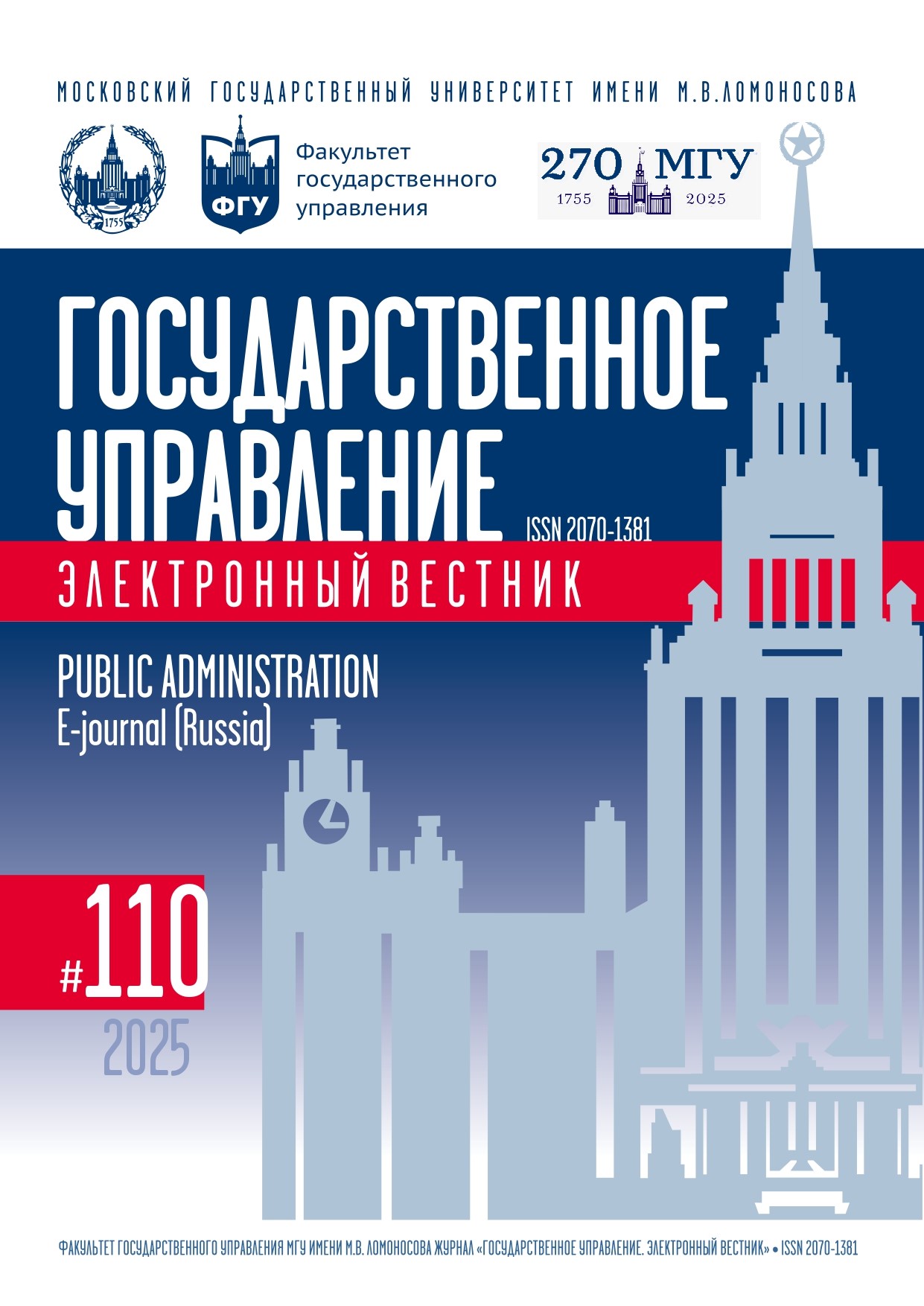Downsizing as а Strategic Tool for Organizational Change
DOI:
https://doi.org/10.55959/MSU2070-1381-110-2025-46-62Keywords:
Change management, downsizing, organizational structure, staff dismissal, convergent strategy of the company, business processes, business model, resistance to change.Abstract
The term “downsizing” is used broadly as a radical reorganization aimed at improving organizational efficiency, productivity and competitiveness, and narrowly as measures to reduce the number of management levels of the organization and the number of staff. Reactive and proactive downsizing strategies are highlighted and characterized in the article. The first is used as a quick response to the sharply deteriorating working conditions of the organization (crisis). The second is used when staff reductions and other activities are carried out as planned, which leads to changes in the business processes, business models and strategy of the organization. The driving forces or factors of downsizing can be grouped into three groups: sanitation, cloning, and organizational learning. Three strategies for downsizing are distinguished and characterized: a strategy for reducing the workforce, a strategy for reorganizing the structure and culture (redesign), and a systemic strategy. The latter involves the most profound and radical changes in the field of not only business processes and structure, but also the culture of the organization. Depending on the speed and depth of changes, a convergent strategy is distinguished (changes affect part of the organization or its individual business processes) and a reorientation strategy that affects the organization more broadly and involves a significant redefinition of its mission, strategy, and structure. The financial, organizational, and human consequences of using these strategies are considered. The likelihood of human consequences is the main obstacle to making decisions about downsizing.
References
Бунина Е.А. Сохранение интеллектуального капитала при даунсайзинге организации // Современные социально-экономические проблемы российского общества: сборник статей по материалам научной сессии Института заочного экономического образования Воронежского государственного университета. Воронеж: Воронежский государственный университет, 2016. С. 6–11.
Гильдингерш М.Г., Бразевич С.С., Маргулян Я.А. Подходы к изучению института высвобождения работников и практика их применения на предприятии // Социология. 2023. № 6. С. 156–162.
Занина Е.Г. Выбор методов управления стратегическими изменениями на предприятии // Экономика. Менеджмент. Инновации. 2020. № 1(25). С. 20–31.
Кристенсен К., Рейнор М. Решение проблемы инноваций в бизнесе. Как создать растущий бизнес и успешно поддерживать его рост. М.: Альпина Паблишер, 2004.
Линц К., Мюллер-Стивенс Г., Циммерман А. Радикальное изменение бизнес-модели. Адаптация и выживание в конкурентной среде. М.: Альпина Паблишер, 2019.
Попова Т.С., Гречкин Е.И. Шринкфляция и даунсайзинг как маркетинговые приемы воздействия на покупательское поведение // Практический маркетинг. 2023. № 9(315). С. 54–56. DOI: 10.24412/2071-3762-2023-9315-54-56
Райхельд Ф. Эффект лояльности. Движущие силы экономического роста, прибыли и непреходящей ценности. М.: Вильямс, 2005.
Рубинфельд А., Хемингуэй К. Созданные для роста. М.: Баланс Бизнес Букс, 2006.
Трансформация бизнес-модели / Harvard Business Review. М.: Альпина Паблишер, 2019.
Чуйкова Т.С. Даунсайзинг: следствия для индивида и организации. // Актуальные проблемы современного общества. Социология. Управление. Политика: Межвузовский сборник научных трудов. Санкт-Петербург: Санкт-Петербургский государственный экономический университет, 2019. С. 53–63.
Agwu Е., Carter А., Murray Р. Downsizing as a Strategic Tool for Effective Organizational Management // International Journal of Research in Management, Science & Technology. 2014. Vol. 2. Is. 1. URL: https://ssrn.com/abstract=3120520
Allen D., Freeman M, Russell J., Reizenstein R., Rentz J. Survivor Reactions to Organizational Downsizing: Does Time Ease the Pain? // Journal of Occupational and Organizational Psychology. 2001. Vоl. 74. Is. 2. P. 145–164. DOI: 10.1348/096317901167299
Amundson N., Borgen W., Jordan S., Erlebach A. Survivors of Downsizing: Helpful and Hindering Experiences // The Career Development Quarterly. 2004. Vol. 52. Is. 2. P. 256–271. DOI: 10.1002/j.2161-0045.2004.tb00647.x
Appelbaum S., Donia M. The Realistic Downsizing Preview: A Management Intervention in the Prevention of Survivor Syndrome (Part II) // Career Development International. 2001. Vol. 6. Is. 1. P. 5–19. DOI: 10.1108/13620430110380990
Budros A. The Mean and Lean Firm of Downsizing: Causes of Involuntary and Voluntary Downsizing Strategies // Sociological Forum. 2002. Vol. 17. P. 307–342. DOI: 10.1023/A:1016093330881
Burke R., Greenglass E. Organizational Restructuring: Identifying Effective Hospital Downsizing Processes // Organization in Crisis / ed. by R. Burke, C. Cooper. Malden, MA: Blackwell, 2000. P. 284–303.
Cameron K. Strategies for Successful Organizational Downsizing // Human Resource Management. 1994. Vol. 33. Is. 2. P. 189–211. DOI: 10.1002/hrm.3930330204
Cameron K. Strategic Organizational Downsizing: An Extreme Case // Trends in Organizational Behavior / ed. by S. Cooper, D. Rousseau. New York: John Wiley, 1998. Vol. 5. P. 185–229.
Cameron S., Freeman J., Mishra K. Downsizing and Redesigning Organizations // Organizational Change and Redesign / ed. by G. Huber, W. Glick. San Francisco: Berret-Koehly Publishers, 1993. Р. 19–53.
Cascio W.F. Downsizing: What do we know? What have we learned? // Academy of Management Executive. 1993. Vol. 7. Is. 1. P. 95-104.
Cascio W.F. Responsible Restructuring: Seeing Employees as Assets, Not Costs // Ivey Business Journal Online. 2003. URL: https://iveybusinessjournal.com/publication/responsible-restructuring-seeing-employees-as-assets-not-costs/
Chopra A. Survival // Best Paper Proceedings of Academy of Management. 2006. Part 2. P. 134-139.
De Meuse K., Bergmann T., Vanderheiden P., Roraff C. New Evidence Regarding Organizational Downsizing and a Firm’s Financial Performance: A Long-Term Analysis // Journal of Managerial Issues. 2004. Vol. 16. Is. 1. P. 155–177.
De Vries K.M.F., Balazs К. The Downsizing of Downsizing // Human Relations. 1997. Vol. 50. Is. 1. Р. 11–50. DOI: 10.1177/00187267970500010
Drew S. Downsizing to Improve Strategic Position // Management Decision. 1994. Vol. 32. Is. 1. P. 4–11. DOI: 10.1108/00251749410050624
Espahbodi J., Vasudevan G. The Effects of Downsizing on Operating Performance // Review of Quantitative Finance and Accounting. 2000. Vol. 15. P. 107–126. DOI: 10.1023/A:1008321929083
Farrell М., Mavondo F. The Effect of Downsizing Strategy and Reorientation Strategy on a Learning Orientation // Personnel Review. 2004. Vol. 33. Is. 4. P. 383–402. DOI: 10.1108/00483480410539470
Fijalkowska A., Hjartаker K., Nesheim T. Lay Off Employees or Terminate Consultant Contracts? Responses to an External Shock in Three Firms in the Norwegian Petroleum Industry // Employee Relations. 2017. Vol. 39. Is. 7. P. 1083–1099. DOI: 10.1108/ER-11-2016-0219
Freeman S. Organizational Downsizing as Convergence or Reorientation: Implications for Human Resource Management // Human Resource Management. 1994. Vol. 33. Is. 2. P. 213–238. DOI: 10.1002/hrm.3930330205
Gandolfi F. Organizational Downsizing: A Review of Two Decades of a Strategic Phenomenon // Sasin Journal of Management. 2010. Vol. 16. Is. 1. P. 85-108.
Gandolfi F., Hansson M. Reduction-in-Force (RIF) — New Developments and a Brief Historical Analysis of a Business Strategy // Journal of Management & Organization. 2010. Vol. 16. Is. 5. P. 727–743. DOI: 10.5172/jmo.2010.16.5.727
Gandolfi F., Neck P. Consequences, Payoffs, and Fallout of Downsizing. A Literature Review of Corporate Downsizing: Рart 3 // Review of International Comparative Management. 2008. Vol. 9. Is. 11. P. 55–78.
Gross R. Organizational Downsizing: The Past and Present Organizational Strategy // International Journal of Research in Business Management. 2015. Vol. 3. Is. 1. P. 24–30.
Kivimäki M, Honkonen T, Wahlbeck K., Elovainio M., Pentti J., Klaukka T., Virtanen M., Vahtera J. Organizational Downsizing and Increased Use of Psychotropic Drugs among Employees Who Remain in Employment // Journal of Epidemiology & Community Health. 2007. Vol. 61. Is. 2. P. 154–158. DOI: 10.1136/jech.2006.050955
Langster Н., Cutrer Sh. A Scoping Review of the Impact of Downsizing on Survivors // JONA: The Journal of Nursing Administration. 2021. Vol. 51. Is. 6. P. 329–333. DOI: 10.1097/NNA.0000000000001022
Liou K., Wang H. Managerial Value, Financial Condition, and Downsizing Reform // Public Personnel Management. 2019. Vol. 48. Is. 4. P. 471–492. DOI: 10.1177/0091026019826144
Littler C. Organizational Downsizing: The Dilemmas of Change // Human Resources Management Bulletin. Sydney: CCH Australia Limited, 1998.
Littler C. Comparing the Downsizing Experiences of Three Countries: A Restructuring Cycle // Organization in Crisis / ed. by R. Burke, C. Cooper. Malden, MA: Blackwell, 2000. Р. 58–77.
Littler C., Gandolfi F. What Happened to Downsizing? Organizational Continuity, Managerial Fashion, and Signaling // Academy of Management Conference. 2008. P. 133–148.
Macky K. Organizational Downsizing and Redundancies: The New Zealand Workers’ Experience // New Zealand Journal of Employment Relations. 2004. Vol. 29. Is. 1. P. 63-87.
Mirabal N., De Young R. Downsizing as a Strategic Intervention // Journal of American Academy of Business. 2005. Vol. 6. Is. 1. P. 39–45.
Mishra A., Mishra R. Downsizing the Company without Downsizing Morale // MIT. Sloan Management Review. 2009. Vol. 50. Is. 3. P. 39–44.
Ryan L., Macky K. Downsizing Organizations: Uses, Outcomes and Strategies // Asia Pacific Journal of Human Resources. 1998. Vol. 36. Is. 2. P. 29-45. DOI: 10.1177/103841119803600204
Sahdev K. Survivors’ Reactions to Downsizing: The Importance of Contextual Factors // Human Resource Management Journal. 2003. Vol. 13. Is. 4. P. 56–74. DOI: 10.1111/j.1748-8583.2003.tb00105.x
Saxena R. Methods for the Study of Downsizing: A Review // IIMA Working Papers No. 2006-12-01. 2006.
Tsai C. Yen F. A Model to Explore the Mystery between Organizations’ Downsizing Strategies and Firm Performance: Integrating The Perspectives of Organizational Change, Strategy and Strategic Human Resource Management // Journal of Organizational Change Management. 2008. Vol. 21. Is. 3. P. 367–384. DOI: 10.1108/09534810810874831
Zyglidopoulos S.C. The Impact of Downsizing on the Corporate Reputation for Social Performance // Journal of Public Affairs. 2018. Vol. 4. Is. 1. P. 11–25. DOI: 10.1002/pa.168
Downloads
Published
Issue
Section
Categories
Similar Articles
- Alla Z. Bobyleva, Valeriy М. Anshin, Designing Sustainable Development Transformation Program for a Company , Public Administration. E-journal (Russia): No. 88 (2021)
- Alexey O. Sokolov, Indicators of Economic Feasibility of Creating Supranational Organizational and Legal Forms within the Eurasian Economic Union , Public Administration. E-journal (Russia): No. 89 (2021)
- Vera S. Shkarina, Intellectual Capital and Management System in Creative Economy Organizations , Public Administration. E-journal (Russia): No. 106 (2024)
- Aleksand S. Voronov, Aleksandr V. Eryomin, Sergey S. Serebrennikov, Personnel Reserve of Educational Organizations of Higher Education and Scientific Organizations: Opportunities for Formation and Management on the Basis of Councils of Young Scientists , Public Administration. E-journal (Russia): No. 101 (2023)
- Valery N. Minat, Ethnocultural Polarization of Government Personnel and the Choice of Public Administration Model (Using the Example of the Southwestern United States) , Public Administration. E-journal (Russia): No. 102 (2024)
- Maria I. Bubnova, Alsu H. Tezyel, Specifics of Organizing Educational Process in the Context of Internationalization (Case Study of Chinese Students of the School of Public Administration, Lomonosov Moscow State University) , Public Administration. E-journal (Russia): No. 106 (2024)
- Anatoly I. Lesnikov, Tatyana P. Kotova, Elvira G. Salisheva, Olga V. Popova, Development of Recreational Potential with Effective Use of Service Resources and Technologies of Rehabilitation after COVID in the Conditions of Sanatorium-Resort Complexes , Public Administration. E-journal (Russia): No. 88 (2021)
- Tatiana V. Gudkova, Stepan A. Sinitsyn, Digitalization as a Factor of Company’s Sustainable Development , Public Administration. E-journal (Russia): No. 93 (2022)
- Tatiana V. Zaytseva, Anna A. Suvorova, The Organizational Support That Encourages Employees-Applicants of Research Organizations to Defend Scientific Papers , Public Administration. E-journal (Russia): No. 99 (2023)
- Alexander S. Koretsky, Principles of Forming Digital Ecosystem of Process Management Based on Business Model , Public Administration. E-journal (Russia): No. 84 (2021)
You may also start an advanced similarity search for this article.




